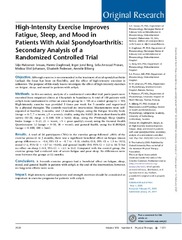High-Intensity Exercise Improves Fatigue, Sleep, and Mood in Patients With Axial Spondyloarthritis: Secondary Analysis of a Randomized Controlled Trial
Permanent link
https://hdl.handle.net/10037/21325Date
2020-05-04Type
Journal articleTidsskriftartikkel
Peer reviewed
Author
Sveaas, Silje Halvorsen; Dagfinrud, Hanne; Berg, Inger Jorid; Provan, Sella Aarrestad; Johansen, Melissa Woll; Pedersen, Elisabeth; Bilberg, AnnelieAbstract
Objective - Although exercise is recommended in the treatment of axial spondyloarthritis (axSpa), the focus has been on flexibility, and the effect of high-intensity exercises is unknown. The purpose of this study was to investigate the effect of high-intensity exercises on fatigue, sleep, and mood in patients with axSpA.
Methods - In this secondary analysis of a randomized controlled trial, participants were recruited from outpatient clinics at 4 hospitals in Scandinavia. A total of 100 patients with axSpA were randomized to either an exercise group (n = 50) or a control group (n = 50). High-intensity exercise was provided 3 times per week for 3 months and supervised by a physical therapist. The controls received no intervention. Measurements were self-reported at baseline, 3 months, and 12 months: fatigue, using the Fatigue Severity Scale (range = 0–7, 7 = worst, ≥5 = severe); vitality, using the RAND 36-item short-form health survey (SF-36, range = 0–100, 100 = best); sleep, using the Pittsburgh Sleep Quality Index (range = 0–21, 21 = worst, >5 = poor quality); mood, using the General Health Questionnaire 12 (range = 0–36, 36 = worst); and general health, using the EUROQoL (range = 0–100, 100 = best).
Results - A total of 38 participants (76%) in the exercise group followed ≥80% of the exercise protocol. At 3 months, there was a significant beneficial effect on fatigue (mean group differences = −0.4, 95% CI = −0.7 to −0.1), vitality (5.0, 95% CI = 1.1 to 10.5), mood (−2, 95% CI = −3.7 to −0.04), and general health (9.0, 95% CI = 3.3 to 14.7) but no effect on sleep (−1.1, 95% CI = −2.1 to 0.2). Compared with the control group, the exercise group had a reduced rate of severe fatigue and poor sleep. No differences were seen between the groups at 12 months.
Conclusions - A 3-month exercise program had a beneficial effect on fatigue, sleep, mood, and general health in patients with axSpA at the end of the intervention; however, no long-term effects were seen.
Impact - High-intensity cardiorespiratory and strength exercises should be considered as important in exercise programs for patients with axSpA.
Methods - In this secondary analysis of a randomized controlled trial, participants were recruited from outpatient clinics at 4 hospitals in Scandinavia. A total of 100 patients with axSpA were randomized to either an exercise group (n = 50) or a control group (n = 50). High-intensity exercise was provided 3 times per week for 3 months and supervised by a physical therapist. The controls received no intervention. Measurements were self-reported at baseline, 3 months, and 12 months: fatigue, using the Fatigue Severity Scale (range = 0–7, 7 = worst, ≥5 = severe); vitality, using the RAND 36-item short-form health survey (SF-36, range = 0–100, 100 = best); sleep, using the Pittsburgh Sleep Quality Index (range = 0–21, 21 = worst, >5 = poor quality); mood, using the General Health Questionnaire 12 (range = 0–36, 36 = worst); and general health, using the EUROQoL (range = 0–100, 100 = best).
Results - A total of 38 participants (76%) in the exercise group followed ≥80% of the exercise protocol. At 3 months, there was a significant beneficial effect on fatigue (mean group differences = −0.4, 95% CI = −0.7 to −0.1), vitality (5.0, 95% CI = 1.1 to 10.5), mood (−2, 95% CI = −3.7 to −0.04), and general health (9.0, 95% CI = 3.3 to 14.7) but no effect on sleep (−1.1, 95% CI = −2.1 to 0.2). Compared with the control group, the exercise group had a reduced rate of severe fatigue and poor sleep. No differences were seen between the groups at 12 months.
Conclusions - A 3-month exercise program had a beneficial effect on fatigue, sleep, mood, and general health in patients with axSpA at the end of the intervention; however, no long-term effects were seen.
Impact - High-intensity cardiorespiratory and strength exercises should be considered as important in exercise programs for patients with axSpA.
Publisher
Oxford University PressCitation
Sveaas S, Dagfinrud HS, Berg Ij, Provan SA, Johansen MW, Pedersen E, Bilberg A. High-Intensity Exercise Improves Fatigue, Sleep, and Mood in Patients With Axial Spondyloarthritis: Secondary Analysis of a Randomized Controlled Trial. Physical Therapy. 2020;100(8):1323-1332Metadata
Show full item recordCollections
Copyright 2020 The Author(s)


 English
English norsk
norsk